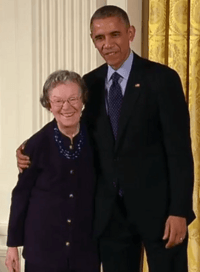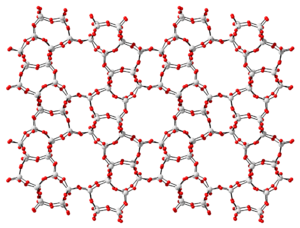Edith M. Flanigen facts for kids
Quick facts for kids
Edith Marie Flanigen
|
|
|---|---|

Edith Flanigen receives the National Medal of Technology from U.S. President Barack Obama on November 20, 2014
|
|
| Born |
Edith Marie Flanigen
January 28, 1929 Buffalo, New York, U.S.
|
| Alma mater | D'Youville College Syracuse University (M.S.) |
| Known for |
|
| Awards |
|
| Scientific career | |
| Fields | Chemistry |
| Institutions | Union Carbide, UOP |
Edith Marie Flanigen (born January 28, 1929) is a famous American chemist. She is known for creating special materials called zeolites. These materials are used as molecular sieves, which help filter and separate different substances. She also helped create synthetic, or man-made, emeralds.
Contents
Early Life and Education
Edith Marie Flanigen was born on January 28, 1929, in Buffalo, New York. She and her two sisters, Joan and Jane, became interested in chemistry because of their high school teacher. All three sisters decided to study chemistry at D'Youville College. Edith was a top student and graduated as class president.
Edith and Joan both continued their studies at Syracuse University. They earned master's degrees in inorganic physical chemistry in 1952. Years later, in 2008, Syracuse University gave Edith an honorary doctorate degree.
A Career in Chemistry
In 1952, Edith Flanigen started working at a company called Union Carbide. Her first job was to find and clean different types of silicone materials. In 1956, she joined a team that worked on molecular sieves.
Edith made history at Union Carbide. In 1973, she became the first woman to be named a corporate research fellow. This was a very important position. Later, in 1986, she became a senior corporate research fellow.
In 1988, she moved to a company called UOP. This company was a partnership between Union Carbide and another company. At UOP, she continued her important research. She was promoted to UOP Fellow in 1991. Edith Flanigen retired from UOP in 1994. Even after retiring, she continued to work as a consultant for UOP until at least 2004.
During her 42-year career with Union Carbide and UOP, Edith Flanigen was incredibly productive. She invented over 200 different man-made substances. She also wrote or helped write more than 36 scientific papers. She was given at least 109 patents for her inventions.
Amazing Chemistry Inventions
Edith Flanigen began working on molecular sieves in 1956. Molecular sieves are like tiny filters made of crystals. They have very small holes, or pores, that can separate different molecules. This allows them to clean or separate very complex mixtures.
Edith Flanigen is most famous for inventing zeolite Y. This is a special type of molecular sieve. Zeolite Y was designed to help refine crude oil, also known as petroleum. When crude oil is refined, it is separated into many different parts. Gasoline is one of these important parts.
Flanigen's zeolites are used as catalysts. A catalyst is a substance that speeds up a chemical reaction without being used up itself. Zeolite Y acts as a catalyst that helps produce more gasoline from petroleum. This makes refining petroleum safer and more efficient.
Besides her work on molecular sieves, Edith Flanigen also helped invent a synthetic emerald. Union Carbide made and sold these man-made emeralds for many years. They were used in special devices called masers, which were like early lasers. For a while, they were even used in jewelry.
Awards and Recognition
Edith Flanigen has received many awards and honors for her work. In 1992, she was the first woman to receive the Perkin Medal. This is a very important award in chemistry. In 2004, she was added to the National Inventors Hall of Fame.
In 2014, a special award was created in her honor. It is called the Edith Flanigen Award. This award is given each year to a talented young female scientist. The first award went to Natacha Krins for her research.
In 2012, Edith Flanigen was given the National Medal of Technology and Innovation. On November 20, 2014, President Barack Obama personally presented her with this medal. It recognized her amazing contributions to science and technology.
List of Awards
- 1991 Chemical Pioneer Award from the American Institute of Chemists
- 1992 Perkin Medal (first female recipient)
- 1993 Garvan Medal
- 2004 National Inventors Hall of Fame
- 2004 Lemelson–MIT Lifetime Achievement Award
- 2012 National Medal of Technology and Innovation
See also
 In Spanish: Edith M. Flanigen para niños
In Spanish: Edith M. Flanigen para niños


